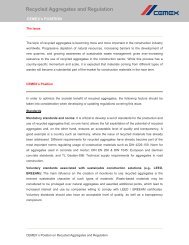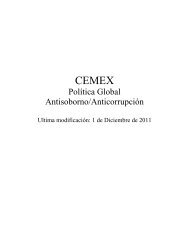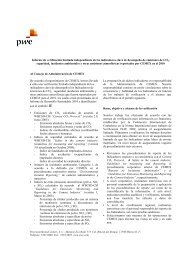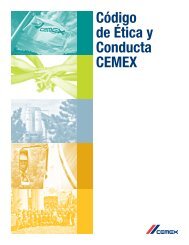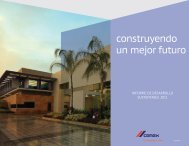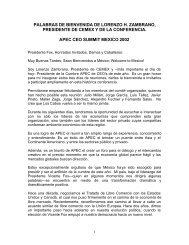building a STRONGER foundation - Cemex
building a STRONGER foundation - Cemex
building a STRONGER foundation - Cemex
Create successful ePaper yourself
Turn your PDF publications into a flip-book with our unique Google optimized e-Paper software.
For the 2010 fiscal year, CEMEX will be required to pay (at the new, 30% tax rate) 25% of the Additional Consolidation Taxes<br />
for the period between 1999 and 2004. The remaining 75% will be payable as follows: 25% for 2011, 20% for 2012, 15% for 2013<br />
and 15% for 2014. Additional Consolidation Taxes arising after 2004 will be taken into account in the sixth fiscal year after their<br />
occurrence and will be payable over the succeeding five years in the same proportions (25%, 25%, 20%, 15% and 15%). Applicable<br />
taxes payable as a result of this tax reform will be increased by inflation adjustments as required by Mexican Income Tax Law (Ley<br />
del Impuesto Sobre la Renta). In connection with the changes in the tax consolidation regime in Mexico, as of December 31, 2009, we<br />
recognized a liability of approximately Ps10.5 billion (approximately U.S.$913.0 million as of April 30, 2011, based on an exchange<br />
rate of Ps11.50 to U.S.$1.00), of which approximately Ps8.2 billion (approximately U.S.$713.0 million as of April 30, 2011, based on<br />
an exchange rate of Mexican Ps11.50 to U.S.$1.00) were recognized under “Other non-current assets” in connection with the net<br />
liability recognized before the new tax law and that we expect to realize in connection with the payment of this tax liability; and<br />
approximately Ps2.2 billion (approximately U.S.$191.3 million as of April 30, 2011, based on an exchange rate of Ps11.50 to<br />
U.S.$1.00) were recognized under “Retained earnings,” considering special provisions under MFRS for the portion, according to the<br />
new law, related to: (a) the difference between the sum of the equity of the controlled entities for tax purposes and the equity for tax<br />
purposes of the consolidated entity; (b) dividends from the controlled entities for tax purposes to CEMEX, S.A.B. de C.V.; and<br />
(c) other transactions among the companies included in the tax consolidation group that represented the transfer of resources within<br />
such group.<br />
On February 15, 2010, we filed a constitutional challenge (juicio de amparo) against this tax reform. As of June 3, 2011 we<br />
were notified of a favorable verdict at the first stage of the trial; the Mexican tax authorities may file an appeal (recurso de revisión)<br />
which will be reviewed by the Mexican Supreme Court.<br />
On March 31, 2010, additional tax rules (miscelanea fiscal) were published in connection with the general tax reform approved<br />
by the Mexican Congress in November 2009. These new rules provide certain taxpayers with benefits arising from the years 1999 to<br />
2004.<br />
On June 30, 2010, CEMEX paid approximately Ps325 million (approximately U.S.$28.3 million as of April 30, 2011, based on<br />
an exchange rate of Ps11.50 to U.S.$1.00) of Additional Consolidation Tax. This first payment represents 25% of the Additional<br />
Consolidation Tax of the “1999 to 2004” period. The remaining 75% will be paid in the following 4 years according to the proportions<br />
mentioned above.<br />
In December 2010, pursuant to certain additional rules, the tax authorities granted the option to defer the calculation and<br />
payment of certain items included in the law in connection with the taxable amount for the difference between the sum of the equity of<br />
the controlled entities for tax purposes and the equity for tax purposes of the consolidated entity. As a result, CEMEX reduced its<br />
estimated tax payable by approximately Ps2.9 billion (approximately U.S.$252.2 million as of April 30, 2011, based on an exchange<br />
rate of Ps11.50 to U.S.$1.00) against a credit to “Retained earnings.” In addition, considering during 2010: a) cash payments of Ps325<br />
million (approximately U.S.$28.3 million as of April 30, 2011, based on an exchange rate of Ps11.50 to U.S.$1.00) ; b) income tax<br />
from subsidiaries paid to the Parent Company for Ps2.4 billion (approximately U.S.$208.7 million as of April 30, 2011, based on an<br />
exchange rate of Ps11.50 to U.S.$1.00) ; and c) other adjustments of Ps358 million (approximately U.S.$31.1 million as of April 30,<br />
2011, based on an exchange rate of Ps11.50 to U.S.$1.00), the estimated tax payable for tax consolidation in Mexico as of<br />
December 31, 2010 amounted to approximately Ps10.1 billion (approximately U.S.$878.3 million as of April 30, 2011, based on an<br />
exchange rate of Ps11.50 to U.S.$1.00). In our U.S. GAAP reconciliation of our 2010 and 2009 financial statements, an income of<br />
approximately Ps2.9 billion (U.S.$236 million) and an expense of approximately Ps2.2 billion (U.S.$171 million), respectively,<br />
recognized under “Retained earnings” under MFRS were reclassified under U.S. GAAP to income tax revenue for the period in 2010<br />
and income tax expense for the period in 2009.<br />
On January 21, 2011, the Mexican tax authorities notified CEMEX, S.A.B. de C.V. of a tax assessment for approximately<br />
Ps995.6 million (approximately U.S.$86.6 million as of April 30, 2011 based on an exchange rate of Ps11.50 to U.S.$1.00) pertaining<br />
to the tax year 2005. The tax assessment is related to the corporate income tax in connection with the tax consolidation regime. As a<br />
result of a tax reform in 2005, instead of deducting purchases the law allows for the cost of goods sold to be deducted, since there<br />
were inventories as of December 31, 2004, in a transition provision the law allowed for the inventory to be accumulated as income<br />
(thus reversing the deduction via purchases) and then deducted from 2005 onwards as cost of goods sold. In order to compute the<br />
income resulting from the inventories in 2004, the law allowed this income to be offset against accumulated tax losses of some of its<br />
subsidiaries. The authorities argued that because of this offsetting the right to use such losses at the consolidated level had been lost,<br />
therefore CEMEX had to increase its consolidated income or decrease its consolidated losses. CEMEX believes that there is no legal<br />
support for the conclusion of the authority and, therefore on March 29, 2011, CEMEX challenged the assessment before the tax court.<br />
73



